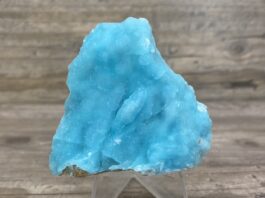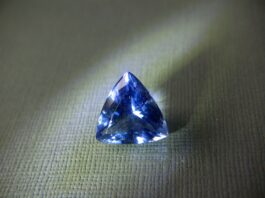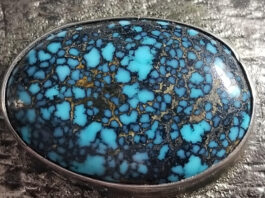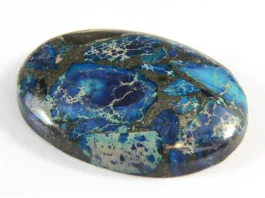Mohave Turquoise, also known as Mohave Green Turquoise or Mohave Blue Turquoise, is a type of turquoise that has been stabilized and often treated to enhance its color. It is not a naturally occurring stone but is created through a process of infusing natural Kingman turquoise with other minerals, such as copper or brass. This infusion results in a striking range of colors, including vibrant greens and blues, often with intricate matrix patterns.

Historically, turquoise has held significant cultural and spiritual importance for many indigenous peoples, particularly in the southwestern United States and among Native American tribes such as the Navajo, Zuni, and Pueblo. It has been used for thousands of years in jewelry, ceremonial objects, and as a form of currency. Turquoise was believed to possess protective qualities and was often worn as an amulet to ward off negative energy and bring good fortune.
Mohave Turquoise, with its rich colors and unique matrix patterns, continues this tradition of reverence for the stone. Its introduction into the market has provided artisans and jewelry makers with a wider range of options for creating stunning pieces of jewelry and art. The infusion of copper or brass in Mohave Turquoise adds depth and complexity to its appearance, making it a popular choice for both contemporary and traditional designs.
In jewelry, Mohave Turquoise is prized for its beauty and versatility. It can be found in a variety of settings, from intricate silverwork in Native American jewelry to modern, minimalist designs in contemporary jewelry. Its vibrant colors and unique patterns make it a statement piece that can complement a wide range of styles and outfits.

In the world of art, Mohave Turquoise is valued for its aesthetic appeal and symbolic significance. It is often used in sculptures, paintings, and other forms of visual art to evoke themes of nature, spirituality, and cultural heritage. Artists appreciate its vivid colors and dynamic patterns, which can add depth and dimension to their work.
Overall, Mohave Turquoise occupies a significant place in the world of jewelry and art, both for its aesthetic qualities and its cultural and historical significance. Whether used in a traditional Native American necklace or incorporated into a contemporary sculpture, Mohave Turquoise continues to captivate and inspire people around the world.
Geological Formation

Mohave Turquoise is a product of human enhancement rather than natural geological formation. It starts with Kingman turquoise, which is a naturally occurring mineral found in Arizona, USA. The Kingman turquoise itself forms through a combination of copper, aluminum, and phosphate-rich groundwater that percolates through host rocks, depositing the turquoise in veins and nodules.
To create Mohave Turquoise, the Kingman turquoise undergoes a stabilization process. This stabilization typically involves infusing the turquoise with other minerals, such as copper or brass, to enhance its color and stability. The exact process may vary depending on the desired outcome, but generally, the turquoise is treated under heat and pressure to allow the additional minerals to permeate the stone, resulting in its characteristic hues of green, blue, or other colors.
While Mohave Turquoise is not a naturally occurring geological formation, its creation involves utilizing and enhancing the properties of natural turquoise. This process allows for a wider range of colors and patterns than may be found in untreated turquoise, contributing to its appeal in jewelry and art.
Physical Characteristics

Mohave Turquoise, being a form of treated and stabilized turquoise, shares many physical characteristics with natural turquoise but may exhibit some differences due to the treatment process. Here are some typical physical characteristics of Mohave Turquoise:
- Color: Mohave Turquoise comes in a range of colors, including vibrant blues, greens, and sometimes even reddish-browns. The coloration can vary depending on the specific minerals used in the stabilization process and any additional treatments applied.
- Matrix: Like natural turquoise, Mohave Turquoise may display matrix patterns, which are veining or web-like patterns caused by the presence of other minerals in the stone. These matrix patterns can add depth and character to the stone’s appearance.
- Hardness: Turquoise typically has a hardness of around 5 to 6 on the Mohs scale, making it relatively soft compared to many other gemstones. Mohave Turquoise maintains this level of hardness, making it suitable for use in jewelry but also requiring care to prevent scratching or damage.
- Luster: Mohave Turquoise often exhibits a waxy to subvitreous luster when polished. This luster gives the stone a smooth and somewhat glossy appearance.
- Transparency: Mohave Turquoise is usually opaque, meaning that light does not pass through it. However, thinner sections or certain cuts of the stone may allow some light to pass through, giving it a semi-translucent appearance in those areas.
- Texture: The texture of Mohave Turquoise can vary depending on the specific treatment and finishing processes applied. It is typically smooth when polished but may retain some natural texture from the original turquoise material.
- Density: Mohave Turquoise has a density ranging from approximately 2.60 to 2.85 grams per cubic centimeter, similar to that of natural turquoise.
Overall, Mohave Turquoise possesses physical characteristics that make it visually appealing and suitable for use in various forms of jewelry and art. Its vibrant colors, unique matrix patterns, and relative ease of treatment and stabilization contribute to its popularity among artisans and consumers alike.
Mining Locations

Mohave Turquoise is a treated form of turquoise, and its production doesn’t involve traditional mining in the same sense as natural turquoise. Instead, Mohave Turquoise is created through a stabilization process applied to natural turquoise, often sourced from mines such as the Kingman Turquoise Mine in Arizona, USA.
The Kingman Turquoise Mine, located in the Cerbat Mountains of northwestern Arizona, has been one of the largest and most productive turquoise mines in North America. It has a long history of producing high-quality turquoise known for its vivid blue color and characteristic matrix patterns. While turquoise mined from locations like Kingman may be used to create Mohave Turquoise, the process of stabilization and enhancement occurs in specialized facilities rather than at the mine site.
In essence, Mohave Turquoise is a product of the treatment and enhancement of turquoise sourced from various mines, with the Kingman Turquoise Mine being a significant contributor to the raw material used in its production. Other turquoise mines around the world may also supply material for stabilization processes, depending on the desired characteristics of the final product.
Applications and Uses

Mohave Turquoise, with its vibrant colors, unique matrix patterns, and enhanced stability, finds a variety of applications and uses in both jewelry and art:
- Jewelry Making: One of the most common uses of Mohave Turquoise is in jewelry making. It is highly prized by artisans and jewelry designers for its striking appearance and versatility. Mohave Turquoise can be fashioned into a wide range of jewelry pieces, including rings, earrings, necklaces, bracelets, and pendants. Its vibrant colors and intricate patterns make it a popular choice for both traditional Native American jewelry and contemporary designs.
- Fashion Accessories: Mohave Turquoise is also used in the creation of fashion accessories such as belt buckles, cufflinks, brooches, and hair accessories. Its bold colors and natural beauty add an eye-catching element to any outfit, making it a favorite among fashion enthusiasts.
- Home Décor: Mohave Turquoise is increasingly being incorporated into home décor items such as decorative bowls, vases, coasters, and tabletop accessories. Its rich hues and unique patterns can enhance the aesthetic appeal of any interior space, from rustic cabins to modern apartments.
- Sculpture and Artwork: Artists and sculptors often use Mohave Turquoise in their creations to add a pop of color and texture. It can be carved into intricate sculptures, inlaid into wood or metalwork, or used as a focal point in mixed media artwork. Mohave Turquoise’s natural beauty and symbolic significance make it a popular choice for both traditional and contemporary art pieces.
- Healing and Spiritual Practices: Turquoise has long been associated with healing and spiritual practices in various cultures. Mohave Turquoise is sometimes used in alternative medicine and holistic healing therapies for its perceived metaphysical properties, such as promoting balance, protection, and emotional well-being.
- Collector’s Items: Due to its unique coloration and treatment process, Mohave Turquoise is often sought after by collectors of gemstones and minerals. Collectors value rare specimens with exceptional color, pattern, and clarity, and may acquire Mohave Turquoise pieces to add to their collections.
Overall, Mohave Turquoise offers a wide range of applications and uses, from adorning the body in jewelry to enhancing the beauty of living spaces and inspiring artistic expression. Its versatility, combined with its natural allure and cultural significance, ensures that it remains a cherished and sought-after material in the worlds of jewelry and art.






